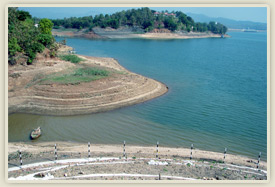In Satpura National Park, there are hundreds of Cave shelters of great archeological interest consisting of large numbers of rock paintings in various styles & belonging to different periods. This National Park consists of a Peculiar bio-diversity of Flora, Fauna, rare Ferms, vegetation, and Migrant Birds. Rich wildlife includes National Animal proud of M.P. “Tiger” along with “Leopards”, “Sambhar”, “Indian Bison (Gour)”, “Crocodile”, “Great Indian Squirrels”, “Flying Squirrels”, “Wild Dogs”, Neel Gaye, Crested Serpent Eagle,


Changeable Hawk Eagles, Honey Buzzards, Paradise Flycatchers, Pittas, Thrushes, Peafowl Black Berg, Sloth Bear, Chital, Barking Dear, Chinkara, Mouse dear, Chousingha, Langoes, Rhesus Monkey, Wolf, Civet, Jackal Wild Boarand lots more throughout the reserve Specialty of this Park lies in its unforgettable scenic beauty with large backwaters of “Tava” & “Denva” River as well as a virgin beauty of River Sonbhadra & Naagdwari. Tourists interested in wildlife, nature lovers, and jungle trackers will love this place for its very different peaceful atmosphere.
Jungle Safari Just like any other national park of Madhya Pradesh, the Jungle Safari system of Satpura National Park is similar to per rules of the Madhya Pradesh Forest Department. Here 4-wheel-driven vehicles (petrol/diesel) are used to park safari. Here no vehicle of more than 5-years old is allowed to go for park-safari. Park entrance charges and guide fee is similar to any other national park in Madhya Pradesh State. Close to Denva river, Forest Department has its counter, from where one can do jungle safari booking and obtain Safari ticket. Using that safari ticket, cross the Denva river, and from the other end, take a jeep for a park safari. In Satpura National Park, one can do a walking safari also. Just like another national park in Madhya Pradesh, safari entrance tickets are almost similar. The jeep fee varies with the duration of Safari. There are 03 slabs of Jeep charge.



History of Satpura
Satpura National Park is nurtured in the Satpura Range of Hoshangabad district in Madhya Pradesh. With the inclusion of Pachmarhi & Bori Sanctuaries, Satpura Tiger Reserve covers 1427 km2. It came to light by British Officer Captain J. Forsyth when he was in action against Indian freedom fighters in 1857. Captain Forsyth belongs to Bengal Cavalary Regiment and was in search of the famous freedom fighter Tatya Tope. While following the information, he accidentally reached the highlands of Central India and find a place suitable for the military base.
Satpura Weather & Climate
Satpura National Park is nurtured and cradled in the Satpura Range and passes through Central India. It has a number of narrow gorges, valleys, and an unspoiled Highland eco-system. Like other national parks of Madhya Pradesh, Satpura Tiger Reserve also remains closed during the rainy season for visitors.
Best time to visit Satpura Reserve
Satpura National Park in the Satpura Range of Hoshangabad district in Madhya Pradesh is open for visitors from 1st October to 30th June. During this time wildlife, lovers can enjoy the Jungle safari rides and boat Safari in Satpura National Park. It is closed for visitors from 01st July till 15th October. Along with adjoining Pachmarhi & Bori Sanctuaries, Satpura National Park covers 1427 km2, otherwise, it covers an area of 524 km2. The unspoiled Highland eco-system of Satpura National Park is unique in nature and was established in 1981.
Denwa River
Denwa River is a lifeline river of Satpura National Park. This river originates from the south-eastern part of the Hoshangabad district in Madhya Pradesh State and flows from east to west direction before joining the Tawa River in the south of Rainpur. The location of Denwa river is Latitude: 22.746128 & Longitude: 77.719356. At the confluence of the Tawa & Denwa rivers, the Tawa dam has been constructed. The river offers a number of activities to visitors. While boating on Denwa River one can enjoy the scenic beauty of Satpura National Park with bird-watching and sighting of marsh crocodiles. In order to do Satpura National Park Safari, tourists have to cross the river through motorboats. All these rivers are tributaries of the holy Narmada river known as the lifeline of Central India. It is an ever-green river assuring the availability of water to wildlife nestling in this forest.
